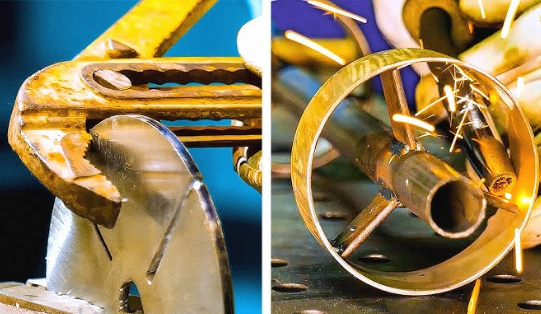Unlocking the Secrets of Metalworking: Key Techniques Every Machinist Should Know

Metalworking is both an art and a science, shaping the backbone of industries ranging from automotive to aerospace. For machinists, mastering metalworking is more than just developing technical skills; it’s about pushing innovation, achieving precision, and creating products that stand the test of time. This guide explores the core and advanced techniques of metalworking, safety practices, materials knowledge, and future trends, empowering machinists to elevate their craft.
Introduction to Metalworking
Metalworking has a storied history that dates back to ancient civilizations. From forging swords for battle to crafting tools for survival, metals have been a constant in human progress. Today, the applications of metalworking have expanded exponentially, powering everything from skyscrapers to microchips.
Modern metalworking combines traditional craftsmanship with cutting-edge technologies. Its importance is evident in industries like construction, medical device manufacturing, and renewable energy. Whether you’re creating precision components for machines or fabricating custom furniture, understanding the fundamentals of metalworking is essential for any machinist.
Essential Safety Measures in Metalworking
Safety in metalworking is non-negotiable. Mishandling tools or materials can lead to severe injuries. Here’s a breakdown of what machinists need to know about staying safe in the workshop:
- Wear Protective Gear: Always gear up with appropriate personal protective equipment (PPE). This includes safety goggles, heat-resistant gloves, steel-toed boots, and ear protection.
- Practice Safe Workspace Habits: Keep your workspace clean and organized. Clutter can lead to accidents, particularly when working with sharp tools or heavy equipment.
- Emergency Protocols: Ensure fire extinguishers, first aid kits, and emergency shut-off buttons are easily accessible. Conduct regular safety drills with your team.
By prioritizing safety, machinists can maintain a productive environment while minimizing risks.
Core Techniques Every Machinist Should Master
Cutting Techniques
Cutting is a foundational skill in metalworking, involving the removal of material to achieve the desired shape or size. Key methods include:
- Sawing: Used to cut large metal pieces into manageable sections. A bandsaw or hacksaw is typically used.
- Shearing: Ideal for making straight cuts in sheet metal. Hydraulic shears are often employed for precision.
- Machining: This process involves removing material with precision tools such as lathes or milling machines. For smooth, even surfaces and exact dimensions, surface grinding services provide an ideal solution.
Read also: Top Skills Needed for a Successful Career in Cybersecurity
Joining Techniques
Joining processes connect two or more metal pieces securely. Common methods include:
- Welding: A versatile technique, welding creates strong and permanent joints. It’s commonly used in construction, automotive, and manufacturing industries.
- Soldering: This method uses a filler metal with a low melting point, ideal for joining smaller components such as electronic circuits.
- Riveting: Often seen in aerospace and construction, riveting creates durable connections without the need for heat.
Forming Techniques
Forming reshapes metal into desired configurations without removing material. Key forming processes include:
- Bending: Used to form metal sheets or rods into various shapes using presses or simple tools.
- Stamping: Common in mass production, stamping involves shaping metal by pressing it into a mold.
- Forging: A historic yet vital technique, forging shapes metal by heating it to high temperatures and applying force.
Advanced Techniques in Metalworking
CNC Machining
Computer Numerical Control (CNC) machines revolutionize metalworking by automating intricate processes. These machines operate with unmatched accuracy, crafting components that meet tight tolerances. CNC machining eliminates much of the guesswork and speeds up production.
Electrical Discharge Machining (EDM)
EDM uses electrical discharges to cut or shape metal. This is particularly useful for hard materials that are difficult to machine using traditional methods. EDM is prized for its ability to create complex and detailed shapes.
Laser Cutting
Laser cutting offers exceptional precision and speed. By focusing a high-powered laser beam, machinists can cut intricate designs into metal sheets with minimal waste. This technique is widely used in industries like automotive and electronics.
Materials Mastery: Understanding Properties and Applications
Selecting the right material is critical to the success of any metalworking project. Each material has unique properties that make it suitable for specific applications. Here’s a quick guide to common materials:
- Steel: Versatile, strong, and widely used in construction and manufacturing.
- Aluminum: Lightweight and corrosion-resistant, perfect for aerospace and automotive applications.
- Copper: Excellent conductivity makes it ideal for electrical components.
- Titanium: Known for its strength-to-weight ratio, often used in medical implants and high-performance equipment.
Understanding material properties such as hardness, tensile strength, and thermal conductivity is essential for machinists to make informed decisions.
Tools of the Trade
A machinist is only as good as their tools. Here’s a list of essentials for every metalworker:
- Hand Tools: Hammers, files, and chisels are the bedrock of traditional metalworking.
- Power Tools: Angle grinders, drills, and saws are indispensable for speeding up processes.
- Precision Instruments: Tools like calipers, micrometers, and surface gauges help ensure accuracy and quality.
Investing in high-quality tools not only boosts efficiency but also enhances the final output.
Best Practices for Quality and Efficiency
To excel as a machinist, focus on these best practices:
- Plan Ahead: Outline every step of your project before starting. This saves time and reduces errors.
- Regular Maintenance: Keep tools and machines in top condition to ensure consistent performance.
- Continuous Learning: Metalworking evolves rapidly. Stay updated by attending workshops, taking courses, and reading industry publications.
Common Mistakes and How to Avoid Them
Even experienced machinists encounter challenges. Here are some common pitfalls and how to prevent them:
- Overlooking Safety Measures: Never skip PPE or emergency protocols, no matter how trivial the task may seem.
- Using the Wrong Tools: Each task requires specific tools. Using the wrong tool can damage your project or equipment.
- Neglecting Measurements: Double-check your dimensions to avoid costly mistakes.
Learning from mistakes is part of the process, but anticipating them ensures smoother workflows.
The Future of Metalworking
The metalworking industry is undergoing a technological transformation. Emerging trends include:
- Automation and Robotics: Robots are automating repetitive tasks, increasing efficiency and safety.
- Sustainable Practices: Eco-friendly technologies, like additive manufacturing (3D printing), are reducing waste.
- Smart Tools: Integration with IoT (Internet of Things) is enabling real-time monitoring and predictive maintenance for machinery.
Adopting these innovations will position machinists as leaders in the evolving manufacturing landscape.
Conclusion
Mastering metalworking requires dedication, attention to detail, and a desire to learn. From understanding materials to honing traditional and advanced techniques, machinists shape the future. To level up your skills, focus on tools like CNCs and processes like surface grinding. Stay curious, stay safe, and keep learning. Start advancing your metalworking journey today.





